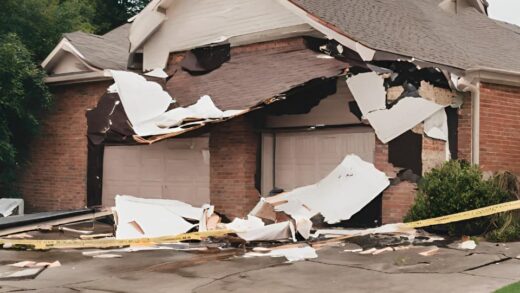Hailstorms can inflict significant damage on your home, from roofing to siding and windows. Repairing hail damage can be costly and stressful. In this article, we’ll explore effective strategies to safeguard your home from hail damage and emphasize the importance of consulting hail damage attorneys Texas for insurance claims.
Understanding Hail Damage
Before diving into protective measures, it’s essential to understand what hail damage entails. Hail damage occurs when hailstones, which can range in size from small pellets to large stones, strike your home with force. These impacts can result in various types of damage, including dented roofing, cracked windows, and punctured siding.
The financial implications of hail damage are significant. Repairing a hail-damaged roof or replacing shattered windows can strain your finances. Fortunately, by taking preventive steps, you can avoid these expenses and protect your home.
Hail-Resistant Roofing Materials
Your roof is the most vulnerable part of your home during a hailstorm. Investing in hail-resistant roofing materials is one of the most effective ways to shield your home from hail damage.
Hail-Resistant Roofing Shingles: Hail-resistant roofing shingles are designed to withstand hail impacts. These shingles are constructed with durable materials that can absorb the force of hailstones without sustaining significant damage. While they may be more expensive upfront, they can save you money in the long run by reducing repair costs.
Metal Roofing: Another option to consider is metal roofing. Metal roofs are highly durable and have a longer lifespan than traditional asphalt shingles. They can withstand hail impact, making them an excellent choice for hail-prone areas. Additionally, metal roofs are energy-efficient, reducing your long-term energy bills.
Impact-Resistant Windows and Doors
Windows and doors are vulnerable points in your home’s defense against hailstorms. Reinforcing these entry points can help protect your home’s interior from hail damage.
Reinforced Windows: Impact-resistant windows are specially designed to withstand hail and other extreme weather conditions. They have multiple layers of glass that are bonded together with a durable interlayer, making them more resistant to shattering upon impact. These windows not only provide protection but also enhance your home’s security.
Upgraded Entry Doors: Just like windows, entry doors can be reinforced to withstand hail damage. Consider upgrading to a high-impact door that can endure severe weather conditions. These doors are not only functional but can also enhance your home’s curb appeal.
Siding and Exterior Protection
Your home’s siding is also susceptible to hail damage. Choosing the right siding material and adding protective features can help minimize the risk of damage.
Hail-Resistant Siding Materials: When selecting siding for your home, opt for materials that are hail-resistant. Vinyl and fiber cement siding are durable choices that can withstand hail impact and protect your home’s exterior. These materials are not only functional but can also enhance your home’s aesthetics.
Protective Awnings and Overhangs: Awnings and overhangs can act as shields for your windows and siding. Installing these features strategically can provide additional protection during hailstorms. Plus, they can add a touch of style to your home’s exterior.
Proper Maintenance and Inspection
Regular maintenance and inspections are essential to ensure your home is prepared to withstand hailstorms.
Routine Roof Inspections: Schedule regular roof inspections, especially after severe weather events. A professional inspection can identify any damage early on, preventing minor issues from escalating into costly repairs. Addressing problems promptly can save you money and stress in the long run.
Gutter Maintenance: Gutters play a crucial role in diverting water away from your home. Clogged or damaged gutters can contribute to water damage, which often accompanies hail damage. Keep your gutters clean and in good condition to ensure they function effectively.
Impact-Resistant Landscaping
Strategic landscaping can provide an additional layer of protection for your home.
Protective Landscaping Features: Consider incorporating landscaping elements that can act as shields against hail. Large shrubs, trees, and outdoor structures can absorb some of the impact from hailstones, reducing the potential for damage to your home.
Hail-Resistant Plants: Choose plants that are resilient to hail damage for your landscaping. These plants are less likely to be harmed by hailstones, preserving the beauty of your outdoor spaces even after a hailstorm.
Insurance Coverage and Documentation
Reviewing your insurance policies and maintaining proper documentation is essential in case of hail damage.
Reviewing Insurance Policies: Take the time to review your homeowner’s insurance policy, specifically the sections related to hail damage coverage. Understand your policy deductibles and coverage limits so you’re well-prepared in the event of a claim. If you have questions or uncertainties, consider consulting with hail damage attorneys who can provide guidance on insurance matters.
Documenting Property: Before and after a hailstorm, document the condition of your home and property. Create a detailed inventory and photograph any damage. This documentation will be invaluable when filing an insurance claim.
Emergency Preparedness
In addition to preventative measures, it’s essential to be prepared for hailstorms.
Creating a Hail Emergency Kit: Assemble an emergency kit that includes essential supplies such as flashlights, batteries, first aid supplies, and emergency contacts. Having these items on hand can help you stay safe during a hailstorm.
Safety Protocols: Establish safety protocols for your family during hailstorms. Identify a designated safe area in your home where family members can seek shelter, away from windows and exterior walls. Practicing these safety measures can help protect your loved ones.
Conclusion
Protecting your home from hail damage is not only a matter of safeguarding your property but also ensuring your peace of mind. By investing in hail-resistant materials, conducting regular maintenance, and being prepared, you can minimize the risk of costly hail damage repairs. Remember, being proactive is the key to protecting your home and family from the unpredictable forces of nature. In case you ever find yourself dealing with a hail damage insurance claim, hail damage attorneys can provide valuable assistance in navigating the complexities of insurance policies and claims.


